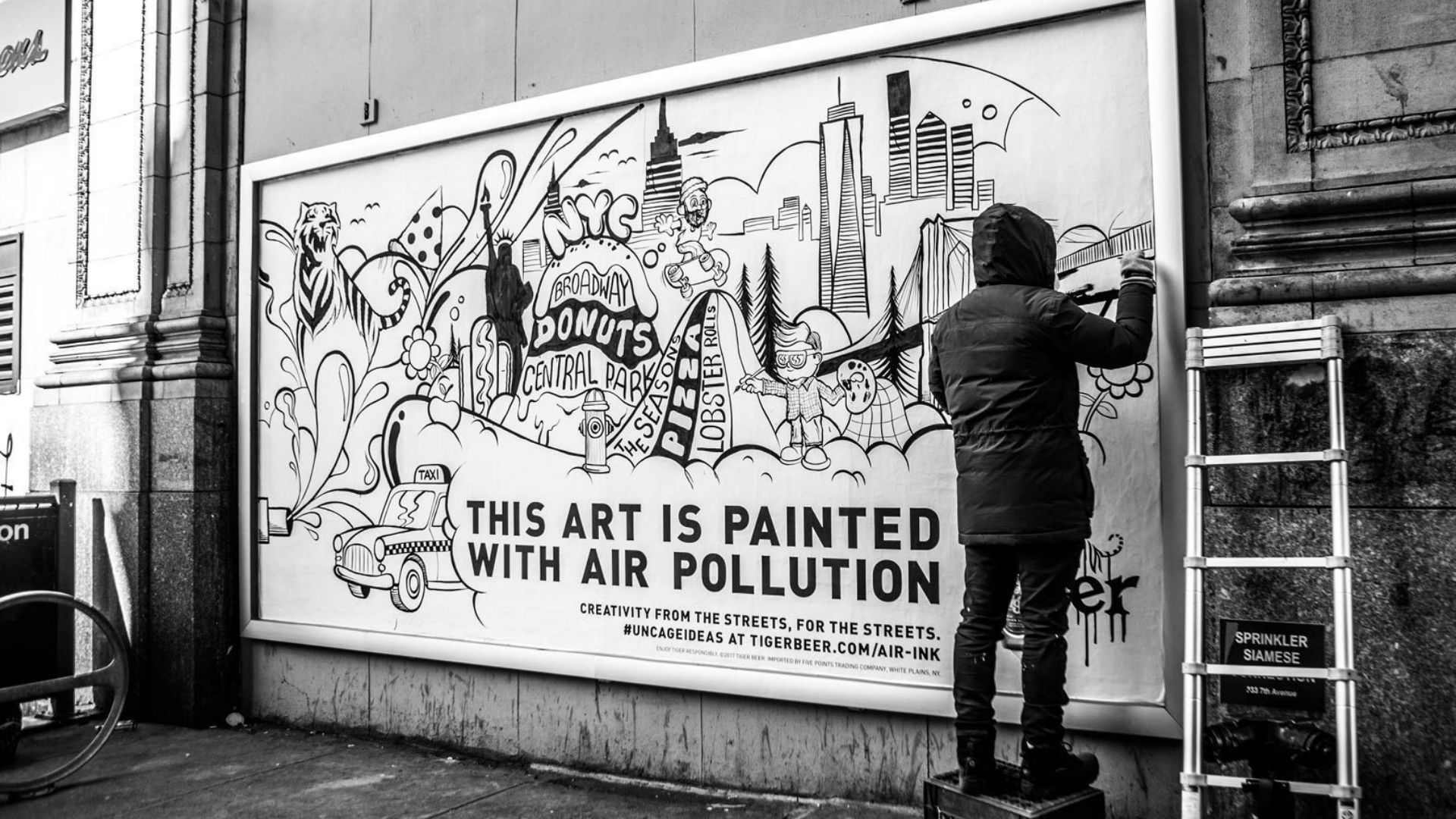Graviky Labs transforms harmful pollution particles into tools for artists.
May 2019

A mural created with Air-Ink in New York City, as part of a “painted with pollution” campaign. Photograph courtesy Graviky Labs
From using vehicles and generating power to manufacturing and mining, human activities create huge amounts of air pollutants every day.
What if these microscopic pollutants could be captured, harnessed and transformed into safe tools we can use, rather than elements of the toxic air that we breathe? This is the central goal of Graviky Labs, a start-up that is helping to redefine how the world understands—and battles—air pollution.
The Bengaluru-based start-up creates a product called Air-Ink, a black pigment made from the carbon soot particles left over when fossil fuels are burned. These air pollutants are captured using a proprietary system, called Kaalink, which attaches to diesel generators and other fossil fuel chimney stacks, and filters their exhaust. Graviky also recycles pollution from other sources, depending upon their carbon content. It purifies and processes the soot, grinding it down into even smaller particles, and works with international testing agencies to ensure that all materials are safe for use. The result? A deep black ink, which has been used by over 1,000 artists around the world to create stunning drawings, murals and more.
Anirudh Sharma first brainstormed the idea for Air-Ink as a student at the Massachusetts Institute of Technology (MIT). The young scientist was visiting his home in Mumbai when he noticed black soot accumulating on his T-shirts throughout the day.
“I realized this was air pollution, or sooty particulate matter, made of black particles released from the exhaust of vehicles,” Sharma told MIT News in 2017. “This is a major health issue.” Indeed, air pollution is becoming an increasingly dire concern around the world. The World Health Organization estimates that millions of people die each year as a result of exposure.
Taking into account the gravity of the situation and the striking, dark color of the pollution particles, Sharma began conducting experiments upon his return to MIT. His first prototypes transformed soot from candles into ink. Further investigation led to the discovery of the way to collect and transform fossil fuel waste into a usable artistic tool. Emerging from the MIT Media Lab, Sharma co-founded Graviky Labs in India in 2016, gaining key funding through a successful Kickstarter crowd-funding campaign. Sponsorship from a beer company helped Graviky share Air-Ink with artists around the world. These artists created public works using the ink, some bearing the text, “This art is painted with air pollution.”
Graviky’s efforts have won the company many awards and drawn international media attention. While transforming air pollution into ink for artists may sound less important when compared to the implications of the problem of global air pollution, Graviky’s work has a real impact. For example, a single pen full of Air-Ink can contain the pollution created by over two hours of a car burning diesel fuel. The company states that 1.6 trillion liters of air have already been cleaned through its efforts.
In early 2017, Buff Monster, a New York City-based street artist, used Air-Ink to paint a billboard on 7th Ave and 28th Street in the city. He also painted a series of five small canvases and one large canvas. All these works with Air-Ink explored the idea of transformation in the city. These were later exhibited at a gallery in Soho, on Earth Day, which explained the concept behind the project. “I love working on black and white artwork, and rarely do I get a chance to work with new technology in my materials,” says Buff Monster in a statement on his website. “So, it was a great project to be involved in. It was such a unique way to turn a negative (pollution) into a positive (artwork).”
Another New York-based artist, Clara Shen, says she only recently learned of Graviky’s painting-with-pollution mission. “I think it’s an ingenious idea, provided it’s somewhat safe to use and produce,” she says. “I’m very curious about it and would definitely be interested to try it in my work.”
Kristopher Ho, a Hong Kong-based artist, was an early tester of Air-Ink and has used it on several projects. Although he had doubts about the quality and usability of the ink at first, his opinion soon changed. “The product proved to be something much better than a marketing campaign,” he says. “The color is a solid black with very little translucency, making it perfect for all surfaces. The texture of the ink is thicker than regular ink in the market, which means, it’s good when working on porous surfaces—quick drying, yet extremely durable.”
Graviky represents a new frontier of environmental technology, one that operates on a creative human level, but could serve as a model for ecofriendly innovation around the world. “Graviky Labs is at the forefront of finding ingenious solutions to some of the toughest problems in our society,” says engineer, educator and Graviky advisor Nell Watson, “spinning dirt into gold.”
Michael Gallant is the founder and chief executive officer of Gallant Music. He lives in New York City.
COMMENTS